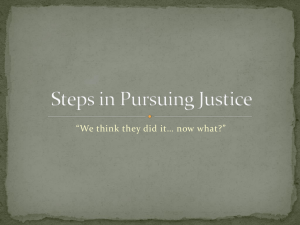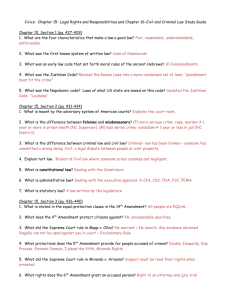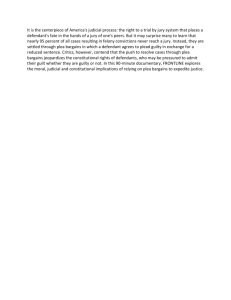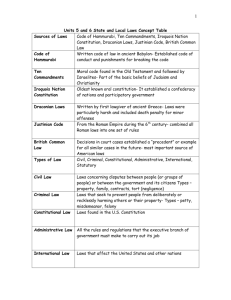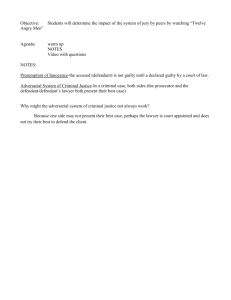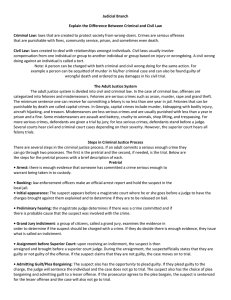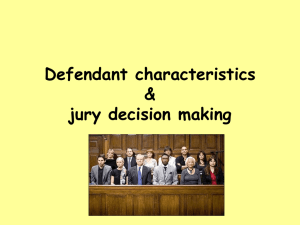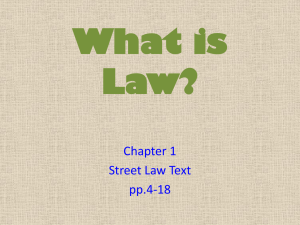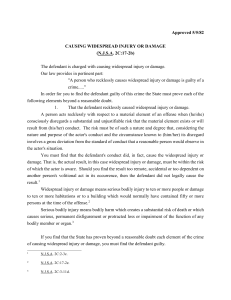Types of Crime and the Law
advertisement
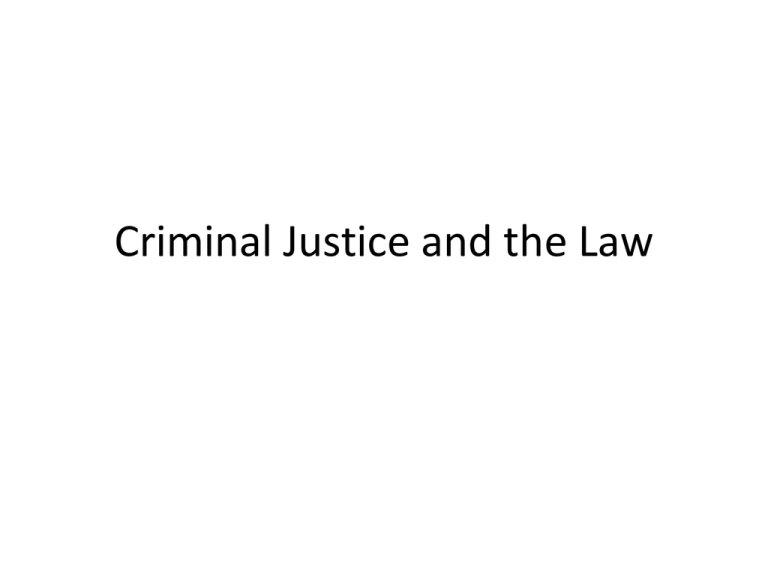
Criminal Justice and the Law The Science in Forensic Science • 1 Observe a problem or questioned evidence and collect objective data • 2 Consider a hypothesis or possible solution to the problem based on observation, giving direction to the work plan. This step inductive reasoning, experience and imagination. • 3 Examine, test, and analyze to support or refute a hypothesis. • 4 Use deductive reasoning to make a determination as to the significance of the evidence. • 5 Evaluate and verify all evidence. This step is especially critical to a forensic scientist because someone’s liberty can depend on the work. All possible errors must be stated. Consideration must be given to standardization, reproducibility, validity, reliability, and accuracy. Civil Law vs Criminal Law Civil law- law that deals with noncriminal suits brought to protect or preserve a civil or private right or matter Criminal law- regulation and enforcement of rights, setting acceptable limits of conduct in society Individual Rights Guaranteed by the Bill of Rights • The right to be presumed innocent until proven guilty • The right not to be searched unreasonably, either on one’s person or in one’s home • The right not to be arrested without probable cause • The right to unreasonable seizure of personal property • The right against self incrimination • The right to fair questioning by police • The right to protection from physical harm throughout the justice process • The right to an attorney • The right to trial by jury • The right to know any charges against oneself Individual Rights Guaranteed by the Bill of Rights • • • • • • • • • The right to cross examine prosecution witnesses The right to speak and prevent witnesses The right not to be tried again for the same crime The right against cruel and unusual punishment The right to due process The right to a speedy trial The right against excessive bail The right against excessive fines The right to be treated the same as others, regardless of race, gender, religious preference, country of origin, and other personal attributes Miranda Rights • The following is a minimal Miranda warning: You have the right to remain silent. Anything you say can and will be used against you in a court of law. You have the right to speak to an attorney, and to have an attorney present during any questioning. If you cannot afford a lawyer, one will be provided for you at the government’s expense. Types of Crimes • Violation- any time a breach of a law has a taken place – Can be minor or major crimes – Crimes are classified as infractions, misdemeanors, or felonies • Infractions- violation of a rule or law that is not punishable by prison • Misdemeanors- a minor crime, less than a felony. – punishable by no more than one year in jail – Fines usually range from $250 to $2500 • Felony- more serious crimes that carry stiffer penalties – Punishable by more than 1 year to life in prison or even death penalty Steps in Pursuing Justice • • • • Crime is reported or discovered…. If crime observed by police officer then can go straight to arrest. Police arrive Investigation by police Processing of crime scene – – • Search and processing of evidence documentation Suspect identified Probable cause = situation in which a reasonable and prudent person, viewing the available information, would conclude that a crime has been committed and that the suspect committed it <<<<If probable cause… • Arrest warrant obtained and booking – – • • Miranda Rights Read Booking= a police procedure following arrest that records basic information about the suspect, a photograph, and fingerprints and perhaps includes a lineup Jail or Bail Arraignment- the first act in a criminal proceeding, where the defendant where the defendant is brought before the court to hear charges and enter a plea – – Usually within 72 hrs of arrest Pleas can be guilty, not guilty, not guilty by reason of insanity, double jeopardy, or nolo contendere (no contest- admit no guilt or innocence yet accept punishment as though he or she was guilty) Steps in Pursuing Justice For Felonies For Misdemeanors • • Preliminary or evidentiary hearing – – – – • No jury Judge hears evidence against defendant Right to cross examination and to produce favorable evidence Judge decides to proceed to trial or dismiss or reduce charges due to insufficient evidence Some states may use grand jury instead of preliminary hearing – – – Grand jury consists of 16-23 individuals sworn in to hear evidence Only prosecutor presents evidence, no cross examination Jury decides by majority vote to indict or not indict suspect • • Indict = formally accuse Trial – If convicted followed by sentencing hearing and prison or probation • – Possible opportunity for appeal if acquitted then released Trial – Conviction or acquittal • • If convicted sentencing If acquitted then released Facets of Guilt To prove a case, the “MMO” must be established; it must be shown that the suspect had: Motive—person had a reason to do the crime (not necessary to prove in a court of law) Means—person had the ability to do the crime Opportunity—person can be placed at the crime scene Burden of Proof • In US, a person is presumed innocent until proven guilty – Burden of proof is on prosecution in criminal court cases • If there is reasonable doubt that defendant committed crime then jurors are instructed to vote not guilty – Takes all 12 jury members to vote guilty to convict – Only 50% of trials lead to conviction of defendent – Only 25% of trials lead defendant serving a year or more in jail/prison Plea Bargaining • Plea Bargaining- an agreement in which a defendant pleads guilty to a lesser charge and the prosecutor in return drops more serious charges to avoid the cost and time of trial – Can occur at many parts of the judicial process – About 90% of criminal cases are plea bargained Federal Rules for Evidence • In order for scientific evidence to be admitted in a court of law, it must be: – Probative: actually proves something – Material: addresses an issue that is relevant or significant to the particular crime • Hearsay- testimony given by a witness who relates not what he or she heard, saw, or knows personally, but what others have said – Knowledge is dependent on credibility of the person who first made the statement and is not considered reliable as it is not taken under oath and does not allow for cross examination. – NOT ADMISSABLE in CRIMINAL TRIALS yet IS ADMISSABLE in CIVIL SUITS Admissability of Evidence • The Frye Standard From the 1923 case Frye v. United States Scientific evidence is allowed into the courtroom if it is generally accepted by the relevant scientific community (particular field of study.) ---The Frye standard does not offer any guidance on reliability. ---The evidence is presented in the trial and the jury decides whether it has significance to the case or not. Admissibility of Evidence The Daubert Ruling- revision of Frye Standard From the 1993 case Daubert v. Dow • The judge decides if the evidence can be entered into the trial. Admissibility is determined by: 1) Whether the theory or technique can be tested 2) Whether the science has been offered for peer review 3) Whether the rate of error is acceptable 4) Whether the method at issue enjoys widespread 5) Whether the theory or technique follows standards • Helps keep junk science (pseudoscience) out of courtroom • Federal Ruling yet states are expected to use acceptance Expert Witness • Expert Witness- person specializing in a particular techinical or scientific area of study • The expert witness presents scientific evidence in court. He/She will: – Establish credibility through credentials, background experience. – Evaluate evidence. – Render an opinion about the evidence (whether or not it incriminates defendant) The court or judge may accept or reject the opinion’s significance. • Both prosecution and defense can present expert witnesses
